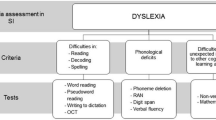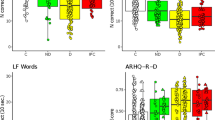Abstract
A majority of Indian schoolchildren are biliterate in that they acquire literacy in at least two language systems, necessitating dyslexia assessment in both. The DALI-DAB assesses risk for dyslexia by evaluating reading ability and literacy-learning potential through a battery including literacy tests (letter and word reading, spelling, nonword reading, reading comprehension), and mediator skills (phonological awareness, processing automaticity and executive fluency, oral language) in multiple languages. DALI-DAB was developed in three languages – English, Hindi, and Marathi – and standardized on a sample of 1013 children. Reliability analyses revealed high internal consistency (α > 0.8) in most tests in all three languages. Low standard error of measurement values supported DALI-DAB score stability over repeated testing. Construct validity was variously reinforced through, (i) selection of culture-referenced, research-based tests, (ii) approval of test materials by schoolteachers (face validity) and (iii) grade-correlated performance increases on all DALI-DAB tests, besides robust correlations between (iv) literacy and mediator skill test scores (p < .001, concurrent validity), (v) equivalent tests across languages (p < .01, convergent validity), and (vi) DALI-DAB and WJ III ACH literacy scores (p < .01, criterion validity), in contrast to (vii) low correlation between DALI-DAB and WJ III ACH math scores (p > .05, discriminant validity). Overall, the DALI-DAB represents the first standardized dyslexia assessment tool for bilingual-biliterate children.



Similar content being viewed by others
Notes
Data from children who scored “0” on the following measures of literacy in both languages were excluded from further analyses: G1 and G2 – letter reading, letter spelling/dictation, word reading and word spelling/dictation; G3 to G5 – word reading, word spelling/dictation.
The DALI toolkit also includes the Junior Screening Tool (JST) and Middle Screening Tool (MST), intended to aid schoolteachers in evaluating students potentially at risk for dyslexia. Details of the JST and MST are described elsewhere (Singh et al. submitted).
Since the rapid picture naming task scores reflected time taken (in seconds) to name the entire card of pictures, negative z score values reflected better performance. Thus, lower standard scores on this task reflect better performance.
Mean z score value always equals zero.
Carver (1974) distinguished psychometric testing, whose aim is the assessment of individual differences, from edumetric testing, which aims to capture the growth in skills and abilities that results from training and instruction. A major challenge in interpreting edumetric test results stems from training/practice effects that may reduce or even eliminate inter-individual and inter-item variance in responses, and in turn cause underestimation of reliability.
References
Bajre, P., & Khan, A. (2019). Developmental dyslexia in Hindi readers: Is consistent sound-symbol mapping an asset in reading? Evidence from phonological and visuospatial working memory. Dyslexia, 25, 390–410. https://doi.org/10.1002/dys.1632.
Berninger, V. W., & Abbott, R. D. (2010). Listening comprehension, oral expression, reading comprehension, and written expression: Related yet unique language systems in grades 1, 3, 5, and 7. Journal of Educational Psychology, 102, 635–651. https://doi.org/10.1037/a0019319.
Bosman, A. M. T., & Van Orden, G. C. (1997). Why spelling is more difficult than reading. In C. A. Perfetti, L. Rieben, & M. Fayol (Eds.), Learning to spell: Research, theory, and practice across languages (pp. 173–194). Lawrence Erlbaum Associates Publishers. https://doi.org/10.1353/lan.1999.0082.
Bruck, M. (1992). Persistence of dyslexics’ phonological awareness deficits. Developmental Psychology, 28, 874–886. https://doi.org/10.1037/0012-1649.28.5.874.
Carlson, K. D., & Herdman, A. O. (2012). Understanding the impact of convergent validity on research results. Organizational Research Methods, 15, 17–32. https://doi.org/10.1177/1094428110392383.
Carver, R. P. (1974). Two dimensions of tests: Psychometric and edumetric. American Psychologist, 29, 512–518. https://doi.org/10.1037/h0036782.
Chee, M. W., Tan, E. W., & Thiel, T. (1999). Mandarin and English single word processing studied with functional magnetic resonance imaging. Journal of Neuroscience, 19, 3050–3056. https://doi.org/10.1523/jneurosci.19-08-03050.1999.
Cherodath, S., & Singh, N. C. (2015). The influence of orthographic depth on reading networks in simultaneous biliterate children. Brain & Language, 143, 42–51. https://doi.org/10.1016/j.bandl.2015.02.001.
Chung, K. K. H., & Ho, C. S.-H. (2010). Dyslexia in Chinese language: An overview of research and practice. Australian Journal of Learning Difficulties, 15, 213–224. https://doi.org/10.1080/19404158.2010.495830.
Ferrer, E., Shaywitz, B. A., Holahan, J. M., Marchione, K., & Shaywitz, S. E. (2010). Uncoupling of reading and IQ over time: Empirical evidence for a definition of dyslexia. Psychological Science, 21, 93–101. https://doi.org/10.1177/0956797609354084.
Fletcher, J. M., Lyon, G. R., Fuchs, L. S., & Barnes, M. A. (2019). Learning disabilities: From identification to intervention (2nd ed.). The Guilford Press. https://doi.org/10.1080/09297040701455171.
Frederickson, N., Frith, U., & Reason, R. (1997). The phonological awareness Battery. NFER-Nelson.
Frost, R. (1998). Toward a strong phonological theory of visual word recognition: True issues and false trails. Psychological Bulletin, 123, 71–99. https://doi.org/10.1037/0033-2909.123.1.71.
Genesee, F., Lindholm-Leary, K., Saunders, W., & Christian, D. (2005). English language learners in US schools: An overview of research findings. Journal of Education for Students Placed at Risk, 10, 363–385. https://doi.org/10.1207/s15327671espr1004_2.
Gresham, F. M., & Vellutino, F. R. (2010). What is the role of intelligence in the identification of specific learning disabilities? Issues and clarifications. Learning Disabilities Research & Practice, 25, 194–206. https://doi.org/10.1111/j.1540-5826.2010.00317.x.
Hogan, T. P., Adlof, S. M., & Alonzo, C. N. (2014). On the importance of listening comprehension. International Journal of Speech-language Pathology, 16, 199–207. https://doi.org/10.3109/17549507.2014.904441.
Hulme, C., & Snowling, M. J. (2016). Reading disorders and dyslexia. Current Opinion in Paediatrics, 28, 731–735. https://doi.org/10.1097/MOP.0000000000000411.
Indefrey, P. (2006). A meta-analysis of hemodynamic studies on first and second language processing: Which suggested differences can we trust and what do they mean? Language Learning, 56, 279–304. https://doi.org/10.1111/j.1467-9922.2006.00365.x.
Jongejan, W., Verhoeven, L., & Siegel, L. S. (2007). Predictors of reading and spelling abilities in first- and second-language learners. Journal of Educational Psychology, 99, 835–851. https://doi.org/10.1037/0022-0663.99.4.835.
Kandhadai, P., & Sproat, R. (2010). Impact of spatial ordering of graphemes in alphasyllabic scripts on phonemic awareness in Indic languages. Writing Systems Research, 2, 105–116. https://doi.org/10.1093/wsr/wsq009.
Nag, S. (2007). Early reading in Kannada: The pace of acquisition of orthographic knowledge and phonemic awareness. Journal of Research in Reading, 30, 7–22. https://doi.org/10.1111/j.1467-9817.2006.00329.x.
Nag, S., & Snowling, M. J. (2012). Reading in an alphasyllabary: Implications for a language universal theory of learning to read. Scientific Studies of Reading, 16, 404–423. https://doi.org/10.1080/10888438.2011.576352.
Nag, S., Chiat, S., Torgerson, C., & Snowling, M. J. (2014). Literacy, foundation learning and assessment in developing countries: Final report. Education Rigorous Literature Review, London: Department for International Development Retrieved from: eppi.ioe.ac.uk/cms/LinkClick.aspx?fileticket=2um7MFZAee8%3d&tabid=3437.
Parrila, R. K., & Protopapas, A. (2017). Dyslexia and word reading problems. In R. K. Parrila, K. Cain, & D. L. Compton (Eds.), Theories of reading development (pp. 333–358). John Benjamins. https://doi.org/10.1075/swll.15.
Perani, D., & Abutalebi, J. (2005). The neural basis of first and second language processing. Current Opinion in Neurobiology, 15, 202–206. https://doi.org/10.1016/j.conb.2005.03.007.
Raman, N., Mona, G. P., Sumathi, T. A., Singh, N. C., & Gaonkar, K. (2020). Role of language in multilingual children with suspected dyslexia: A pilot study. Journal of Neurology & Neurophysiology, 11, 001–005. https://doi.org/10.36648/2155-9562.11.2.314.
Rand. (2002). Reading for understanding: Toward an R&D program in reading comprehension. Author Retrieved from: www.rand.org/pubs/monograph_reports/MR1465.html.
Raven, J., Raven, J. C., & Court, J. H. (2003). Manual for Raven’s progressive matrices and vocabulary scales. Section 2: The Coloured Progressive Matrices. Pearson.
Seymour, P. H. K., Aro, M., & Erskine, J. M. (2003). Foundation literacy acquisition in European orthographies. British Journal of Psychology, 94, 143–174. https://doi.org/10.1348/000712603321661859.
Shanahan, T. (2006). Relations among oral language, reading, and writing development. In C. A. MacArthur, S. Graham, & J. Fitzgerald (Eds.), Handbook of writing research (pp. 171–183). The Guilford Press. https://doi.org/10.1111/j.1467-873X.2008.00423.x.
Share, D., & Daniels, P. (2016). Aksharas, alphasyllabaries, abugidas, alphabets and orthographic depth: Reflections on Rimzhim, Katz, and Fowler (2014). Writing Systems Research, 8, 17–31. https://doi.org/10.1080/17586801.2015.1016395.
Shaywitz, B. A., Fletcher, J. M., Holahan, J. M., & Shaywitz, S. E. (1992). Discrepancy compared to low achievement definitions of reading disability: Results from the Connecticut longitudinal study. Journal of Learning Disabilities, 25, 639–648. https://doi.org/10.1177/002221949202501003.
Singh, N. C., & Sumathi, T. A. (2019). The role of phonological processing and oral language in the acquisition of reading skills in Devanagari. In R. Joshi & C. McBride (Eds.), Handbook of Literacy in Akshara Orthography. Literacy Studies (Perspectives from Cognitive Neurosciences, Linguistics, Psychology and Education) (Vol. 17). Springer. https://doi.org/10.1007/978-3-030-05977-4_14.
Smythe, I., Everatt, J., Al-Menaye, N., He, X., Capellini, S., Gyarmathy, E., & Siegel, L. S. (2008). Predictors of word-level literacy amongst grade 3 children in five diverse languages. Dyslexia, 14, 170–187. https://doi.org/10.1002/dys.369.
Stuebing, K. K., Fletcher, J. M., LeDoux, J. M., Lyon, G. R., Shaywitz, S. E., & Shaywitz, B. A. (2002). Validity of IQ-discrepancy classifications of reading disabilities: A meta-analysis. American Educational Research Journal, 39, 469–518. https://doi.org/10.3102/00028312039002469.
Tunmer, W., & Greaney, K. (2010). Defining dyslexia. Journal of Learning Disabilities, 43, 229–243. https://doi.org/10.1177/0022219409345009.
Vagh, S. B., & Nag, S. (2019). The assessment of emergent and early literacy skills in the akshara languages. In R. Joshi & C. McBride (Eds.), Handbook of Literacy in Akshara Orthography. Literacy Studies (Perspectives from Cognitive Neurosciences, Linguistics, Psychology and Education) (Vol. 17). Springer. https://doi.org/10.1007/978-3-030-05977-4_13.
Viswanatham, K. (2001). The eighth schedule and the three language formula. In C. J. Daswani (Ed.), Language Education in Multilingual India (pp. 299–333). UNESCO.
Wolf, M., & Katzir-Cohen, T. (2001). Reading fluency and its intervention. Scientific Studies of Reading, 5, 211–239. https://doi.org/10.1207/S1532799XSSR0503_2.
Woodcock, R. W., McGrew, K. S., & Mather, N. (2001). Woodcock-Johnson III tests of achievement. Riverside Publishing.
Ziegler, J. C., & Goswami, U. (2005). Reading acquisition, developmental dyslexia, and skilled reading across languages: A psycholinguistic grain size theory. Psychological Bulletin, 131, 3–29. https://doi.org/10.1037/0033-2909.131.1.3.
Acknowledgements
The authors are very grateful to Priyanka Patel, PhD student at the University of Jyväskylä, Finland, for generously sharing data and insights obtained during her internship in 2018–2019 at the Mahatma Gandhi Institute of Education for Peace and Sustainable Development, New Delhi, when she carried out assessments on Indian schoolchildren using the English DALI-DAB. We also gratefully acknowledge Prof. Smita Deshpande (Ram Manohar Lohia Hospital, New Delhi) for valuable suggestions on the manuscript.
Funding
DALI-DAB was developed as part of a research grant from the Cognitive Science Initiative of the Department of Science and Technology (Grant No: 100/(IFD)/7475/2012-13 DATED 12.02.13), Government of India.
Author information
Authors and Affiliations
Corresponding author
Additional information
Publisher’s note
Springer Nature remains neutral with regard to jurisdictional claims in published maps and institutional affiliations.
Rights and permissions
About this article
Cite this article
Rao, C., T. A., S., Midha, R. et al. Development and standardization of the DALI-DAB (dyslexia assessment for languages of India – dyslexia assessment battery). Ann. of Dyslexia 71, 439–457 (2021). https://doi.org/10.1007/s11881-021-00227-z
Received:
Accepted:
Published:
Issue Date:
DOI: https://doi.org/10.1007/s11881-021-00227-z




